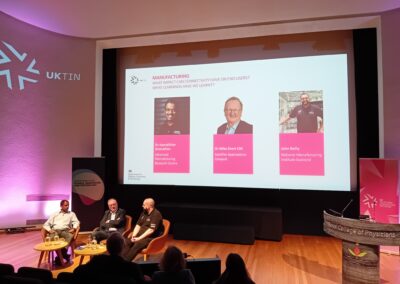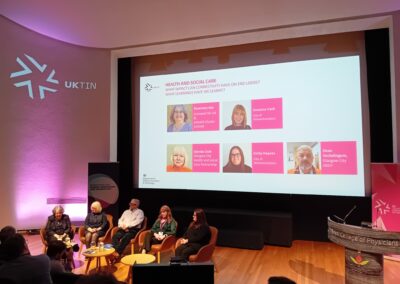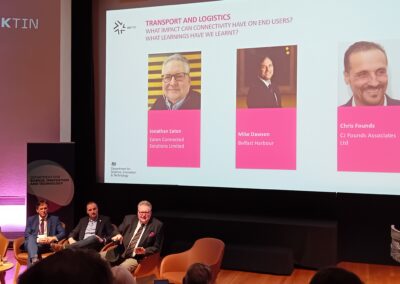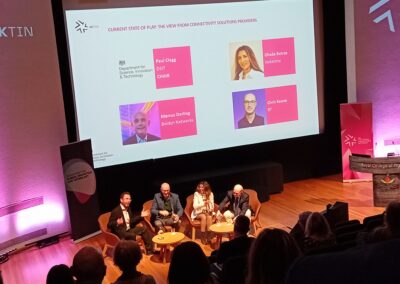ECH team participates in Connectivity’s Role in Digitalising Public Services for Growth
On 28 January, the ECH team had the opportunity to exhibit and participate in panel discussions at the UKTIN event, ‘The Role of Connectivity in Digitalising Public Services for Growth’.
Our team showcased our projects at a stand among other 5G Innovation Region displays. It was fascinating to engage with other 5G Innovation Region teams from across the UK and discuss our respective projects, supported by the Department for Science, Innovation and Technology (DSIT).
We also attended themed panel discussions where experts delved into the various industries that will be impacted by the 5G pilot projects.
A highlight of the event was panellist Dr. Mike Short CBE, Chief Architect at Satellite Applications Catapult and Chair of the UK Telecoms Innovation Network (UKTIN) Advisory Board, who is a key stakeholder in our ECH project at Harwell. Dr. Short participated in the advanced manufacturing panel, where the lively discussion underscored the vast potential of 5G in the advanced manufacturing sector.
We captured some of the discussion below, which featured Dr Aparajithan Sivanathan of the Advanced Manufacturing Research Centre asking the questions.
Interviewer: Mike, can you tell us about the evolution of cell phone usage in manufacturing?
Mike Short: Initially, people wanted cell phones, often the size of a brick. But today, it’s much more about having private networks that might route calls directly to an extension in a factory. They use telecommunications to help with their supply chain and international collaboration with key specialist partners in the factory itself. It is much more of a data world than the voice world of the 1980s.
Interviewer: How has the management of connected machines evolved over the years?
Mike Short: Over the last eight to ten years, there’s been a lot more movement on connected machines. The management of machines with connectivity works well, whether it be with Wi-Fi, cellular, or other technologies. Some manufacturing relies on a campus environment, an industrial estate, or a science park. For example, at the Harwell science park where I work, ECH is putting in place a private 5G network with the help of Oxfordshire County Council and implementation with Vodafone.
Interviewer: Why is this connectivity needed in scientific research and manufacturing?
Mike Short: It’s needed for better collaboration both on the campus and to and from the site. There’s a lot of interest in connectivity being resilient, not just for voice but for data analytics and the measurement of big data. We also need to consider how this connectivity plays a part in satellite communication. We have other clusters at the science park, such as quantum, med tech, and energy tech. Better connectivity helps with data analytics, efficiency, and attracting the right skills.
Interviewer: How does connectivity impact skill shortages in manufacturing?
Mike Short: Connectivity is crucial for addressing skill shortages. You can’t get everybody to one location all the time. Collaboration is necessary, and attracting skills to a 21st-century manufacturing environment is key. Better connectivity makes it easier to collaborate and attract the right talent.
Interviewer: Mike, can you tell us about the importance of looking at different sectors when it comes to connected machines?
Mike Short: Absolutely. If you don’t look at it by sector, you can misfire badly. For example, people who are making machines are quite different from those making biscuits. Similarly, those in consumer electronics differ from those in precision arts and crafts. The volume equation is crucial here; it has to be cost-effective at scale, or it won’t be done. Connected machines are part of this, and larger mechanised plants often require software upgrades where connectivity makes a real difference. They may also need to feed data from the machine itself to measure output. Security varies by sector too. For instance, manufacturing defence equipment requires very secure connected machines.
Interviewer: How does cost factor into this?
Mike Short: Cost is a factor, but it doesn’t start there. Understanding and education are usually the big issues. Sharing knowledge about what can be done and ensuring the use case fits well are crucial. Cost alone shouldn’t be singled out. Coverage is also important; unless you have confidence that indoor and outdoor coverage meets your needs, you may be held back regardless of the cost. Security concerns can also cause hesitation. However, the variety of use cases today is multiplying, and manufacturing is part of that because everyone needs to be efficient. Supply chains need to be organised, and productivity and efficiency together are key.
Interviewer: Can you give an example of how connected machines are being used effectively?
Mike Short: Sure. John Deere tractors at the Consumer Electronics Show in Las Vegas are a great example. They promote connected tractors to help make farmers more efficient, especially on large North American farms. This could become more efficient in Europe as well, depending on the size of the farm. The broader variety of use cases is not declining; it’s expanding.
Interviewer: What about the educational aspect you mentioned earlier?
Mike Short: Education is a significant factor. Many people hear about 5G and think it sounds expensive and not beneficial. However, when considering the total cost of ownership, the cost benefit becomes clear. Not having to run cables can save money, and 5G can support productivity and the supply chain. It’s an education problem; people need to understand the benefits and how it can save costs in the long run.
Interviewer: Any final thoughts on the future of connected machines?
Mike Short: The future is promising. The variety of use cases will continue to grow, and as more people understand the benefits and cost savings, adoption will increase. It’s about sharing knowledge, ensuring security, and having confidence in the coverage.
Photos from the conference
Check out more photos from the conference below!




